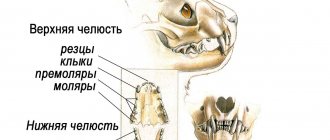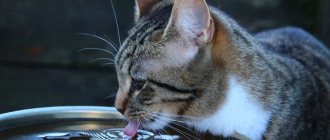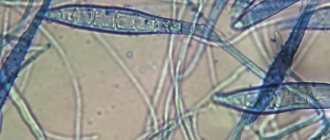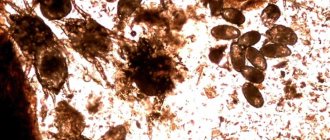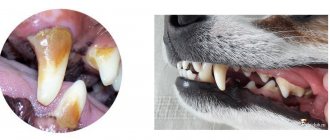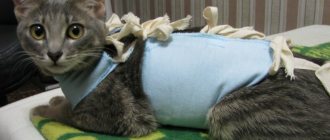Dental health for a cat is the key to its well-being. Inexperienced owners assume that animals do not need additional dental care. In reality this is not the case. Without proper care, plaque accumulates on your pet's teeth, which eventually turns into tartar.
Anyone who has had to remove such a formation in a dentist's office knows well what it looks like and what discomfort it causes. In cats, stone is also a serious problem.
Removal
Removing tartar is a rather painful procedure that causes discomfort in the mustachioed one.
In order for your pet to undergo the procedure without stress and without pain, general anesthesia is used. The removal method is selected individually by a veterinarian and depends on the severity of the lesion:
- Laser removal - used for small stone sizes, if the pathological process has not yet affected the sinuses of the gums. This method is painless; anesthesia is necessary to immobilize the pet. The advantage of laser stone removal is that there is no risk of damage to enamel and soft tissue.
- Grinding – carried out with minor plaque. First, a special paste is applied to the teeth, which has a disinfecting and disinfecting effect. This paste helps even out tooth enamel. During the grinding process, partial removal of the enamel occurs and the gums may be injured. However, these complications are usually inevitable.
- Manual method . The procedure is carried out with special instruments and is used in severe cases of the disease, if there are plaques and extensive growths.
- Fluoridation is an additional step in the stone removal procedure that is recommended. The main task is to coat the crowns with a special varnish or gel containing sodium fluoride. Fluoridation reduces the increased sensitivity of dental tissue and has a strengthening effect on the enamel. In addition, fluoridation helps prevent the development of caries.
- Polishing is the final stage of the procedure. After grinding, the enamel remains rough, which greatly increases the likelihood of the stone forming again. To prevent relapse, the enamel must be polished to a perfectly smooth state. Polishing is carried out using specialized pastes and brushes.
Ban on anesthesia. There are cases when it is not possible to use anesthesia - these are:
- old age of the pet - anesthesia can cause negative consequences, including death;
- kidney, liver and heart diseases;
- abnormalities in the functioning of the central nervous system;
- tendency to allergic reactions.
If there is a risk of complications that could negatively affect the health of the animal, the procedure is carried out in several stages.
Actions after the procedure. After removing the pathological formation, it is recommended to give the cat painkillers, follow a diet, serving light, warm food.
Painkillers should also be given if necessary. Due to the risks of relapse in the future, the owner should carefully monitor the condition of the pet’s oral cavity.
To agree to anesthesia or not
For this manipulation, it is proposed to put the animal under anesthesia. Let's look at why. The device itself produces a sound that is unpleasant for sensitive ears, especially when in contact with a surface, which causes stress in the animal. Also, you cannot explain to the animal why all this is being done to him, and believe me, it is a rare cat that will lie calmly during such manipulations. All these stress factors can cause consequences in animals, such as: shortness of breath, hypoxia (lack of oxygen), and can provoke a worsening of the cardiovascular system. The water that is required to cool the surfaces can get into the trachea, which will also cause a lot of problems. If the animal is not relaxed, then during this procedure you can significantly damage the oral cavity, since again, I repeat, a rare animal will sit quietly and wait for you to do your job, and barbaric methods of fixation such as tying to a table are unacceptable. And most importantly, the conscious animal will not allow you to open your mouth as much as possible and get to the most inaccessible places, such as molars (the last molars). So that the veterinarian can calmly perform his work efficiently and the pet does not experience discomfort, an injection of light anesthesia is offered for relaxation.
How to detect tartar in a cat?
Supragingival calculus can be seen with the naked eye. You can see what it looks like in the photo below: it is a yellow formation near the gums. Observing the animal's behavior will help you suspect that your pet has tartar. Additional signs of this dental problem include:
- chewing food on one side of the jaw;
- frequent rubbing with the paw on the side where the stone is located;
- yellowing of teeth;
- secretion of a large amount of saliva;
- swelling of the lower jaw or swelling under the eyes;
- loosening of teeth, their loss;
- the animal shows anxiety when chewing, shaking its head when eating;
- unpleasant odor from the mouth.
Additional signs appear when the stone has led to complications and the pet has developed caries, periodontal disease or other diseases. It is extremely important to remove such formations in a timely manner to prevent inflammation.
How to tell if your cat has oral problems
You should definitely pay attention to the following symptoms in your pet:
- The cat refuses to eat. The appetite is present, but when approaching the bowl of food, he eats very little and carefully. Complete refusal of solid food, preference is given to food that can only be lapped.
- Unpleasant odor from the mouth.
- Increased, almost constant salivation.
- A clear desire to constantly rub the muzzle and cheeks against various objects.
- Some swelling of the eyes that cannot be explained by external factors.
- Increased irritability of the cat, including periodic shaking of the head with dissatisfied rumbling.
Examination of the oral cavity reveals:
- on the surface of the teeth there are stone-like growths of yellow or green-black color;
- inflamed and bleeding gums;
- teeth with limescale are loose, sometimes barely holding on to the gingival sockets;
- swelling of the mucous membrane around the gums, on the inner surface of the cheeks;
- ulcerations on the mucous membrane of the mouth with seizure of the gums (signs of stomatitis).
Prevention
Proper nutrition plays a huge role in the prevention of tartar. It is necessary to balance the diet, give the cat the opportunity to gnaw solid food - cartilage, chicken necks, dried tendons. In winter, sprout special grass in a tray.
Pet stores usually offer a large assortment of preventative “treats” - tasty chewable tablets with chlorophyll. Chlorophyll eliminates unpleasant odor from the mouth, stops the growth of pathogenic bacteria, and relieves gum inflammation.
It’s a good idea to teach your pet to brush its teeth from childhood. Just be sure to purchase a special toothpaste and brush. Pastes for humans contain fluorides and are absolutely not suitable for animals. Toothpaste for cats usually contains chlorophyll or enzymes and prevents the formation of tartar.
Preventive measures
It is recommended to visit the veterinarian once every six months so that he can examine the animal’s oral cavity for the formation of tartar. If it is not possible to visit a veterinary clinic, you need to regularly examine your pet yourself.
Timely cleaning of teeth from plaque (about once every 5 days) can significantly reduce the risk of tartar formation. It is recommended to introduce the animal to this procedure from a very early age so that its indignation does not interfere with cleaning.
There are a variety of toothpastes and brushes on the market that are made specifically for cats, but you can simply use your index finger to clean the plaque off your teeth.
Regular dental examination and brushing are the most effective means of preventing dental plaque.
The food your cat eats should contain tough ingredients and grass. There are foods on sale that contain special granules that clean the surface of the teeth mechanically and contain polyphosphates; they settle on the teeth and prevent the formation of plaque. Taking multivitamins helps maintain dental health. And by allowing your cat to chew on cartilage, chicken necks, or letting you play with a toy, you will reduce the likelihood of plaque on your teeth to a minimum.
If an animal has digestive diseases, they should be treated in order to restore the chemical balance in the mouth and thereby reduce the risk of tartar formation.
Video: how to properly brush your cat's teeth
Why is tartar dangerous?
Tartar in cats contributes to the formation of gum pockets. Hardened deposits irritate the gum and cause it to move away from the tooth. This can lead to the following complications:
Gum inflammation in a cat
- Gingivitis. This is an inflammation of the gums, which is manifested by redness and swelling. In severe cases, ulcers may appear on the affected areas.
- Periodontitis. This is the name of a disease in which a healthy tooth becomes loose. It can be complicated by the appearance of pus from the gum pocket, abscesses and fistulas of the gums, and inflammation of the lymph nodes located under the jaw.
Diagnosis of pathology
If you notice alarming symptoms in your furry friend, you should be wary. These phenomena in a cat can be symptoms of both tartar and other dental diseases.
To make sure that the problem is indeed fossilized plaque, you can perform the following test. To do this, just moisten a cotton swab with Lugol's solution or iodine (5%) and rub your teeth with it, grabbing the gums adjacent to them. After performing this manipulation, the stone is clearly visible.
The plaque on the enamel may be removed after such a procedure, but the supragingival stones will remain and acquire a dark brown color. However, this method is suitable for identifying only supragingival stone. The subgingival calculus will be detected by the dentist during an examination.
It is best to entrust the diagnosis of the presence of tartar in a cat to a veterinary dentist. This is a narrow specialist with extensive experience. The examination is carried out using a special dental mirror: the mucous membrane of the cheeks and tongue is carefully checked for the presence of ulcers and lesions, and the condition of the teeth and gums is assessed.
Content
1. How to recognize a cat’s tendency to this disease? 2. Tartar in cats: symptoms and consequences 3. How to remove tartar in a cat 4. How to treat tartar in a cat? 5. Removing tartar from a cat at home 6. Prevention of tartar in cats
Tartar in cats is a very insidious disease that can occur completely unnoticed by the owners in the initial stages. It is extremely difficult to identify a problem at an early stage, but it is even more difficult to correctly prevent its occurrence.
As a rule, tartar in a cat is formed as a result of insufficiently thorough, irregular oral hygiene. The consequence of this is the appearance of an animal-like foul odor in the mouth, as well as painful sensations when chewing food. If you ignore this problem for too long, your beloved pet may lose its teeth completely. To prevent this from happening, you should stock up on at least basic knowledge about this dangerous disease.
Tartar is a dense, hard plaque that accumulates due to the vigorous activity of microorganisms. The accumulation of lime is rough to the touch and has a cloudy brown color. This problem is mainly observed in pets under one year of age. At an early stage of development, tartar accumulates as a result of the accumulation of pathogenic microorganisms on the surface of the animal’s fangs. As a result, the teeth are affected by hard particles that grow over time.
The main prerequisites for the formation of tartar in cats include:
- presence of rotten teeth;
- inflammatory processes affecting the gingival mucosa;
- absence of at least one antagonist tooth;
- impaired metabolism of minerals (leads to an imbalance of phosphorus and calcium).
Veterinarians also name several factors that increase the risk of developing the disease:
- wrong choice of cat food;
- lack of solid natural food in the animal’s diet that can remove plaque naturally;
- irregular and insufficiently thorough oral hygiene of the pet (or its absence in principle).
Getting your teeth cleaned by a specialist
Tartar in cats is cleaned off; no specific therapeutic treatment is carried out. The veterinarian has two main ways to remove stone from a cat's grin:
- Removing tartar in cats mechanically involves literally scraping and tearing off hard deposits from the teeth with special metal tools. Naturally, the method is quite traumatic; there is a high risk of damage to the gums and stripping of tooth enamel. Almost no one uses mechanical cleaning in modern veterinary medicine, because... The method is really very dangerous, and on the rough surface of the teeth (from damaged enamel), stone will be deposited even faster and stronger over time.
- Ultrasound removal is a safer, more effective and painless method. For this purpose, special ultrasonic scaling devices are used.
After any method of cleaning, the teeth are additionally polished. This is done with a special antibacterial paste, which not only smoothes the tooth surface, but also fights bacteria.
Of course, the procedure is performed under anesthesia if there are no contraindications for its administration. In both cases the animal is fixed. If cleaning is carried out under general anesthesia, then an inspection of the entire oral cavity is performed at the same time and bad teeth are removed, which do not perform their functions, but are only a source of infection.
To clean tartar without anesthesia, the procedure will have to be divided into several stages, depending on the complexity of the deposits. A cat is a very mobile and evasive animal, which is quite difficult to fix in one position for a long time without unnecessary movements.
If there are signs of bleeding - especially after the removal of bad teeth - it is enough to use cotton-gauze swabs soaked in ordinary 3% hydrogen peroxide. At the very end, cleaning is completed by treatment with antiseptic solutions or gels:
- Chlorhexidine;
- Miramistin;
- Furacilin;
- Holisal;
- Metrogyl Denta gel;
- Lugol's solution, etc.
In special cases, if there are signs of advanced stomatitis, a course of antibiotic therapy may be necessary.
How is a tumor removed in veterinary clinics?
Clinics have special tools for removing tartar from the teeth of four-legged patients. The procedure itself is unpleasant and painful, so it is often performed under general anesthesia in a clinic setting.
Before choosing a stone removal method, the doctor determines where it is located. You can get rid of the formation mechanically or using ultrasound.
Mechanical chipping is performed with a special dental blade - a skeller. The surface of the units is first treated with lactic acid so that the stone comes off better. When manually removed, there is a risk of accidentally damaging the gums or compromising the integrity of the tooth surface. For this reason, ultrasonic cleaning is preferable.
This procedure can last from 40 minutes to several hours. Before surgery, the animal should not be fed for 12 hours. Cats aged 5 years and older need to undergo a preliminary examination to make sure that the anesthesia will not harm their body.
Treatment options
Tartar removal is carried out in veterinary clinics. The procedure is carried out under general anesthesia, as it causes the animal very unpleasant sensations and severe pain.
The animal is prepared in advance for cleaning the teeth from tartar: young (under 3 years old) healthy cats are not given any food at least 12 hours before the procedure, and animals older than 3 years or having any chronic diseases undergo, in addition, additional examination: tests are taken, a thorough examination is carried out.
The procedure for removing tartar lasts on average from 30 minutes to 1 hour, depending on the degree of tooth damage. It includes the following steps:
- Mechanical chipping. At this stage, the growths are lubricated with lactic acid. Then they begin to chip away the stone using a skeller (a special dental device).
- Ultrasound cleaning. This manipulation is necessary to remove small parts. In the initial stage of tartar formation, when the growths are still small, ultrasonic removal is usually sufficient. This procedure does not injure the tooth tissue, unlike mechanical chipping. This is why it is so important not to start this process.
- Grinding and polishing. A special paste is applied to the teeth, which destroys pathogenic bacteria and allows you to even out damaged enamel. The treated oral cavity is rinsed with an antiseptic and treated with an astringent so that tartar cannot form again.
In rare cases, when the cat is too old, has a serious medical condition, or has an allergic reaction to the anesthesia, the scaling procedure can be performed without general anesthesia. In this case, the animal is given painkillers, and the stone is removed in several passes.
The procedure for removing tartar is very painful, so it is performed under general anesthesia.
After the operation, you should create a gentle regime for the cat: offer food that is not solid, slightly warm. It is often necessary to give the animal medications for pain.
It is almost impossible to remove tartar on teeth at home due to the complexity and pain of the procedure. You shouldn’t even try to mechanically remove it yourself. This can lead to painful shock for the animal and serious health problems. If it is impossible to take your pet to the clinic, you can use a chemical method of elimination, for example, using Tropiclean gel. When applied to teeth, it softens growths and destroys pathogenic bacteria. The way to use it is quite simple:
- 30 minutes before using the gel, the cat should not be given food or water.
- It is necessary to apply the product in the amount of two drops to the animal’s teeth and immediately brush them with a toothbrush.
- The product is used daily for a month, and then it can be used as a preventative measure 2 times a week.
It is difficult to get rid of tartar at home, but you can try to remove it with special chemicals.
The advantage of this method of removal is the absence of such a stressful situation as anesthesia and a visit to the veterinarian. But this method requires much more time and effort, in addition, the gel will not be able to cope with subgingival tartar.
How to prevent tartar in a cat?
Prevention will help avoid the need for ultrasonic cleaning. It provides quite accessible measures:
- Hygienic teeth cleaning. It is recommended to do it daily. If this is not possible, hygiene procedures should be performed at least once a week. It is recommended to accustom your cat to them from an early age.
- Use of medicated cleansing feeds. There are dry foods that help gradually remove the stone.
- Regular visits to the veterinarian , who can examine the animal’s mouth and give recommendations on how to care for its teeth. Timely detection of formations on them will help prevent the appearance of large deposits that cannot be removed painlessly.
- Taking vitamin and mineral supplements. They will strengthen the cat’s immunity and help prevent inflammatory diseases in the mouth.
Share with friends!
Bottom line
It is important to remember that the health of your pet is entirely in your hands. Therefore, if you can pay enough attention to caring for it, your pet will be able to please you for a long time, and there will simply be no need to spend time and money on treatment. It is important from early childhood to accustom the kitten to the necessary hygiene procedures and get used to dedicating time and effort to them. This will bring many good fruits in the future. Your care and perseverance will help your cat live a happy, serene life with your family. And her love and gratitude can be the best reward for your efforts.
Causes
Tartar is a hardened plaque on the enamel, which is formed due to the deposition of food particles, bacteria, and mineral elements: phosphorus and magnesium, calcium and iron. Gradually this plaque thickens and hardens. However, not all cats develop tartar. A number of provoking factors lead to this phenomenon:
- improper diet, which includes mainly soft foods;
- disruption of the body's mineral metabolism process;
- bite defects;
- congenital and acquired dental diseases;
- hereditary predisposition;
- rough tooth enamel.
In some cases, the formation of tartar is associated with non-compliance with hygienic care of the pet, the absence of such a procedure as brushing the teeth.
Risk group. In addition, there is a certain category of cats that are especially prone to developing tartar on the surface of their teeth, namely:
- breeds: Persian, Siamese, fold and British cats;
- animals living on the street.
Reasons for fossils
Dental problems can be caused by the following factors:
- lack of timely hygienic treatment of the oral cavity;
- trauma, extensive deep caries, gum damage;
- the absence of a neighboring tooth on the opposite jaw, which provides friction when chewing food;
- malocclusion or curvature of the jaw bones;
- metabolic disorders in the animal's body;
- incorrectly selected diet;
- drinking tap water.
If your cat is at risk, do not neglect preventive visits to your veterinarian.
How to identify and treat pathology?
Detection of calcareous deposits on teeth is carried out during a routine examination by a veterinarian using a special mirror. The doctor must check for inflammation, damage, and tumors in the oral cavity.
After the examination, therapy is prescribed, during which the cat’s tartar is removed. It is best to give preference to specialists in this matter. Home remedies do not always help cope with pathology. With their help it is better to prevent the disease.
You can remove tartar from your cat's teeth using the following methods::
- Mechanical. This method involves the use of dental instruments to remove the stone. This procedure can damage the teeth if the doctor is not careful or the cat starts to struggle.
- Ultrasonic. This method is considered safer. It consists in cleaning the tartar from a cat’s teeth using an ultrasonic machine.
Currently, veterinarians prefer to remove the stone in three stages:
Symptoms
If you notice the following symptoms in your pet, contact your veterinarian immediately:
- the cat constantly shakes its head, as if trying to independently free itself from some foreign body;
- a strong unpleasant smell of rotting emanates from the mouth;
- soreness, redness, bleeding gums;
- brown and yellow deposits on teeth;
- the cat eats little, shows anxiety, or completely refuses food due to painful sensations similar to pulpitis.
Neglected cases lead to caries, gingivitis, stomatitis, periodontal disease, as well as diseases of the nasolacrimal ducts and ears.
Causes
The following are the reasons for the formation of dentolits:
- Inflammation of the gums.
- Dental diseases.
- Loss of one of the opposing fangs.
- Increased mineral metabolism.
- Feed exclusively wet food.
- Congenital roughness of teeth.
- A plaque forms, which gradually hardens
Predisposing factors for the formation of dental stones are considered to be a deficiency of Ascorbic acid or an increased need for it due to an infectious disease. An unfavorable background is created by prolonged use of steroidal antiphlogistics, which destroys collagen fibers.
Types of stones
Dentoliths form mainly where a lot of saliva is produced - on the lower incisors and molars. There are superficial stones, clearly visible and hidden, formed on the root of the tooth.
Danger of dentolitis
With improper nutrition, dental plaque forms, gradually mineralizing and hardening. Only a veterinary dentist can rid a cat of an unpleasant formation. Unremoved dentoltitis grows, leading to gingivitis and tooth loss.
Gingivitis
What is tartar on dogs' teeth?
The process begins with the appearance of plaque on the enamel of the front surface of the teeth or at the very gums. The mass consists of food debris mixed with saliva and serves as an excellent environment for the development of bacteria. Over time, this mixture compacts, and after 4-6 months it hardens to the state of stone.
A dog with healthy teeth feels great
For your information! Initially, the color of the soft coating is light yellow. As it hardens, it darkens, becoming dark brown or even black.
Possible reasons for the appearance
There are several reasons why tartar appears on dogs' teeth. Here are the most common ones:
- poor nutrition;
- violation of water-salt metabolism;
- acidity level in saliva;
- sugar abuse;
- malocclusion and other problems of dental structure;
- lack of hygiene procedures.
Preventive actions boil down to identifying what caused the formation of the stone and eliminating this cause.
Plaque prevention
As for preventive measures, it is enough to follow simple rules so that you will never again wonder how to remove tartar at home. Proper care includes the following:
- Complete cessation of unhealthy habits. We are talking about smoking, consumption of excessive amounts of sweets, coffee and black tea that affect dental health.
- Quality food. Regular consumption of fresh vegetables, herbs and dairy products helps cleanse the enamel.
- Purchase a new toothbrush every month.
- Regular visits to the dentist. It is recommended to visit a dentist once every six months.

